Act CRM: We Test & Review Act! CRM (2025 Update)
Quick summary:
Act! CRM is ideal for small and medium-sized businesses prioritizing client relationship management and marketing automation. This CRM offers a highly customizable sales pipeline and effective customer management, catering to businesses aiming to optimize their sales strategies. This recommendation is based on extensive testing and analysis carried out by our CRM experts despite noting a somewhat traditional user interface.
Act! CRM, a contact management pioneer since the 1980s, has transformed from its initial incarnation as "Automated Contact Tracing" into a robust, cloud-based CRM platform, adeptly combining its legacy strengths with contemporary marketing automation.
Today, Act! has evolved into a SaaS cloud app. It is a full-featured CRM offering advanced digital marketing features to help businesses of all sizes effectively manage customer relationships and streamline their sales processes.
In this in-depth Act CRM review, we examine the tool's strengths, areas where it could improve, and pricing. We understand that choosing the right CRM system is crucial for your business growth, and our goal is to equip you with all the necessary details and help you make an informed decision.
Act! overview: What is Act Software and What is Act Used for?
ACT is customer relationship management (CRM) software for small businesses to mid-size companies. Act! CRM helps organizations track and manage their customer relationships in one place. In a nutshell, this software makes it simpler for companies to decide how to deal with their consumers by centralizing all company contacts in one place.
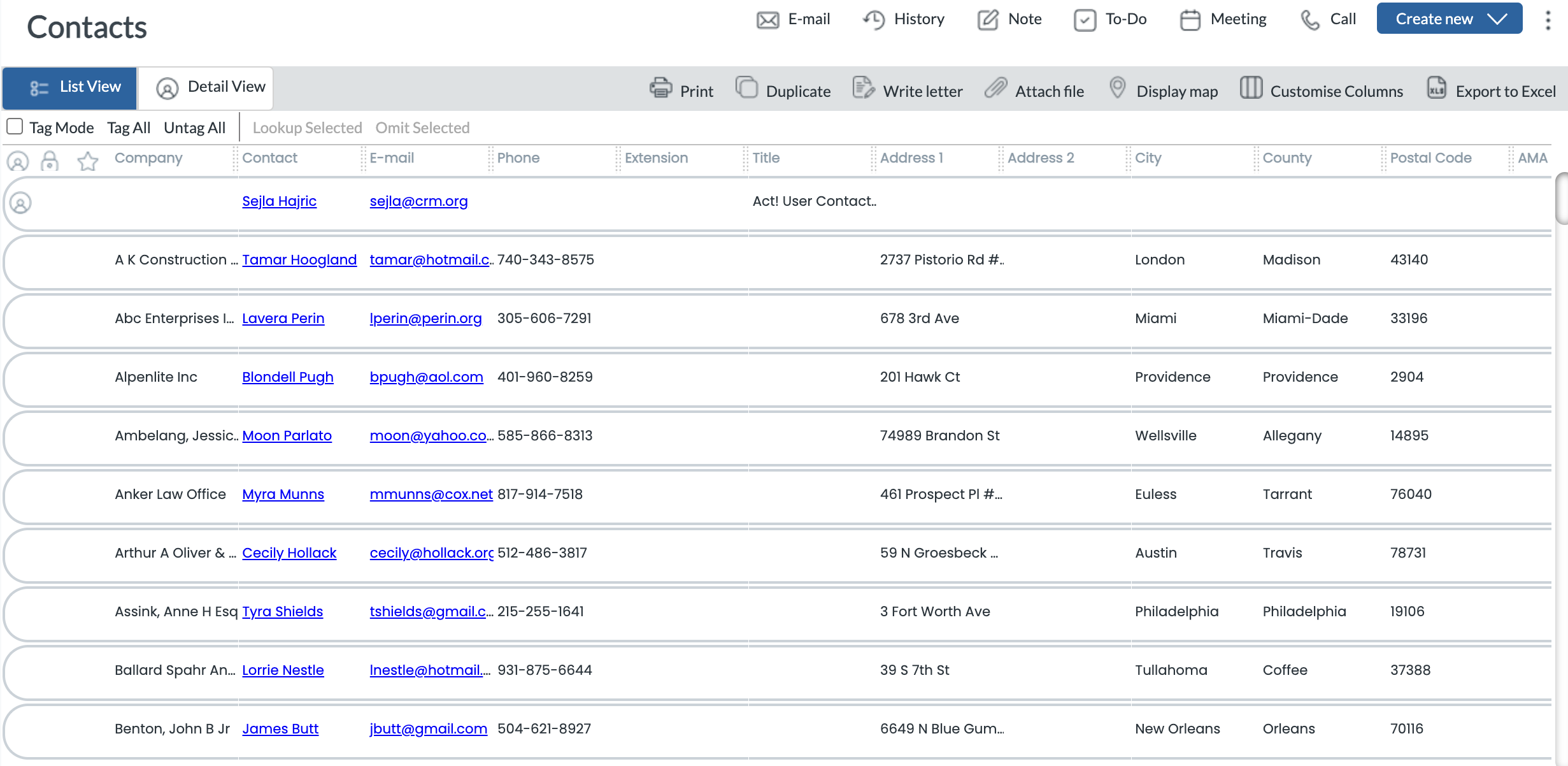
The ACT contact manager can store customer data such as contact information, track customer interactions, manage sales opportunities, and more. ACT also offers optional digital marketing features businesses can use to cultivate customer relationships.
The marketing automation feature makes it easier for businesses to attract new prospects and turn them into customers. The sales pipeline management feature lets companies stay on top of their deals and close opportunities faster.
ACT CRM software is available in both on-premise and cloud-based versions. The premium cloud-based ACT app can be accessed from any device with an internet connection, making it a more flexible option for businesses that have employees working remotely or in multiple locations.
The desktop version is available for all Windows computers. Unfortunately, there isn't a dedicated Mac desktop application. Mac users can run Act! CRM via their browsers only. In addition, the CRM mobile app is available for all Android and iOS devices.
Act CRM Review 2025: Is Act! CRM software system any good?
After our comprehensive Act contact manager review, we believe this software is a solid choice for small to medium-sized businesses. The latest version of Act CRM is particularly renowned for its highly customizable sales pipeline, and it excels at customer management thanks to features that cater precisely to the nuanced needs of small to medium-sized businesses.
The tool's user-friendly marketing automation and detailed contact management system empower these businesses to streamline their sales and marketing processes, making it an invaluable asset in their CRM arsenal.
Act! CRM Pros and Cons
Here are the advantages and disadvantages of the Act! CRM software:
Act! Pros:
Robust contact management: Efficiently manages detailed contact information and interactions.
Effective sales pipeline management: Visual representation of the sales pipeline allows for tracking and managing leads and deals effectively.
Customization options: Offers the ability to customize fields and tailor sales processes to specific business needs.
Marketing automation integration: Marketing automation capabilities streamline campaigns and lead management.
Comprehensive learning resources: Provides ample educational resources, including a Training Video Library and Knowledge Base.
Act! Cons:
Potentially dated user interface: Some users might find the CRM's interface outdated compared to newer CRM systems like HubSpot or Salesforce.
Scalability limitations: While practical for small to mid-sized businesses, it might only partially meet the needs of larger enterprises.
Initial learning curve: New users may require time to grasp the extensive features and functionalities fully.
Extra cost for enhanced support: Enhanced support comes with an additional cost.
Here’s a quick overview of the tool’s main features and how well they scored, according to our CRM experts.
Act! CRM Features Overview
Feature | Rating |
Sales Automation | 3.5/5 |
Contact Management | 4/5 |
Reporting & Analytics | 3/5 |
Marketing Automation | 4/5 |
Email Integration | 3/5 |
Sales Engagement Tools | 3.5/5 |
Customer Service & Support | 3/5 |
Integrations | 3/5 |
Customization and Flexibility | 4/5 |
Ease of Use | 3/5 |
Usability and User Interface
Logging into Act! CRM, for the first time, can be quite a sensory overload. The left sidebar neatly lists all the CRM features, offering quick navigation, while the right sidebar, dubbed "What’s New," keeps you updated on the latest CRM news and updates, thankfully with an option to close it for a less cluttered view.
At the top, a functional menu with a handy search bar provides quick access to essential functions like "Edit," "Lookup," "Schedule," and "Write." Even though the top menu adds to the utility, it contributes to the interface's crowded feel.
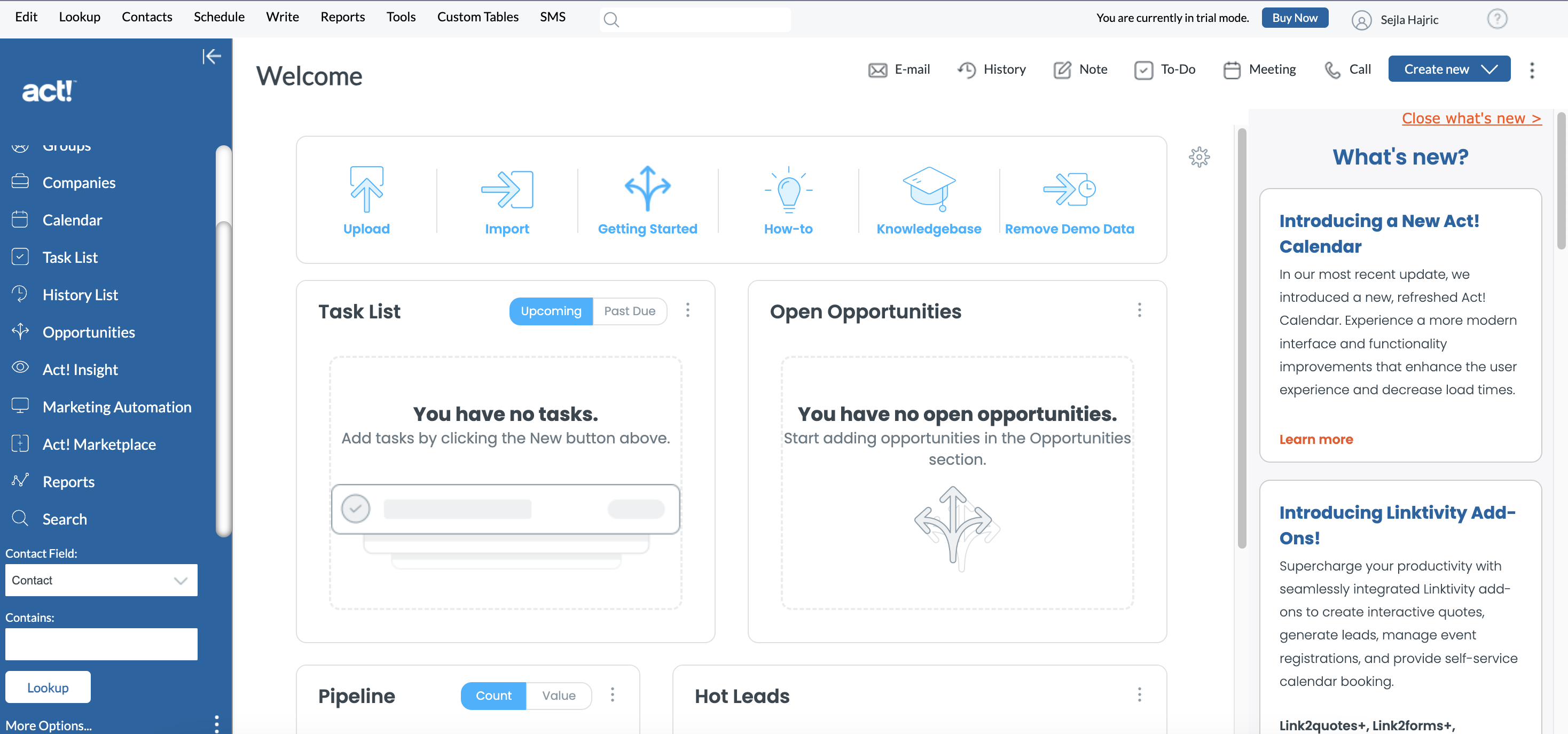
The dashboard, the heart of the interface, is populated with various widgets that display crucial information at a glance – from daily tasks to open opportunities and the sales pipeline to hot leads. Helpful 'Welcome Links' for uploading, importing, and learning about the CRM demonstrate Act! CRM's commitment to user onboarding and support.
However, it's important to note that the user interface feels somewhat dated, and our CRM experts stated it reminded them of older software for Microsoft Windows. And, while Act! CRM packs many features and functionalities, but its user interface may not appeal to those accustomed to more modern, minimalist designs.
Also, our CRM testers stated that the information-dense layout could be overwhelming, especially for those new to CRM. Adapting to this interface took me about 30-60 minutes - a testament to the CRM’s learning curve, which aligns with common user feedback in this area.
However, once over this initial hurdle, the interface proves functional and comprehensive, offering everything a business needs for effective CRM management.
Contact Management: Contacts & Companies
We found Act! CRM's approach to managing contacts and companies is robust and detailed, yet some nuances require attention. The process of importing contacts, initiated by a simple pop-up window, is straightforward but limited to .csv file formats.
Once again, the old-school design strikes here because the pop-up window resembles the installation window on older versions of Microsoft Windows.
 But, back to contact import. The flexibility to choose between typical and custom field mapping is a notable advantage. First, we opted for custom mapping, which was an efficient process that took less than 5 minutes, provided that your .csv file was well-organized.
But, back to contact import. The flexibility to choose between typical and custom field mapping is a notable advantage. First, we opted for custom mapping, which was an efficient process that took less than 5 minutes, provided that your .csv file was well-organized.
For those selecting the typical mapping, all your fields must align precisely with Act! CRM's database expectations; any deviation requires custom mapping.
If you want to add your custom fields, click “Tools” in the top menu and choose “Define Fields.” Then, you can customize existing fields and add your own. When creating a new field, you name it, choose field data type (characters, numbers, website, etc.), and tick several checkboxes. For example, you can allow your field to accept empty values or have your field use a drop-down list.

The “Contacts” feature has two views: 'List View' and 'Detail View'. The 'List View' gives a general overview of all entries, whereas the 'Detail View' dives deep into each contact or company, showing detailed information such as activities, opportunities, and tasks. However, a drawback of 'Detail View' is the inability to switch between contacts quickly; we had to navigate using arrows, which can be time-consuming.
The 'Companies' feature mirrors the 'Contacts' structure, with both 'List View' and 'Detail View' available. The 'Detail View' is particularly effective here, presenting the company's detailed contact information and a list of all companies in the left sidebar, making navigation faster.
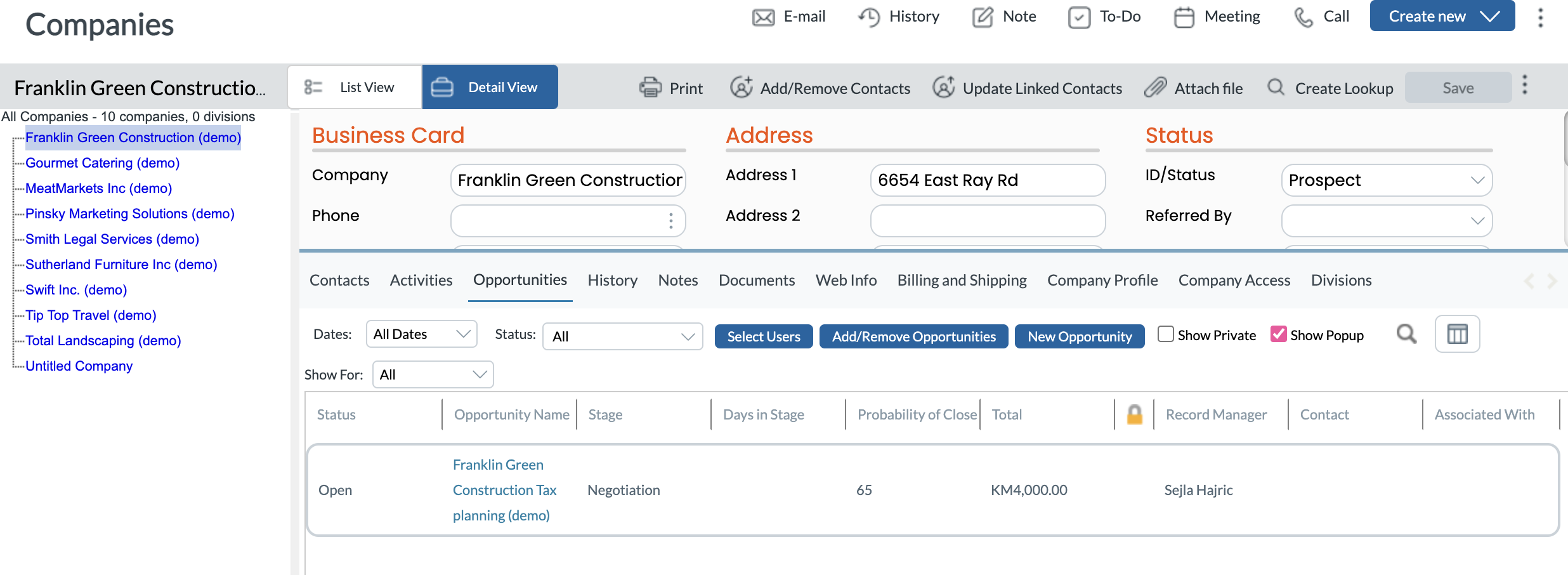
Opportunities
When we opened the “Opportunities” feature for the first time, it took us a few minutes to figure out what was happening since none of our deals were displayed under the “Pipeline” view. Then, we realized that the pipeline is date-centric - it will show opportunities only for your chosen period.
For example, we added a few deals with open and estimated close dates in the previous quarter. When we filtered to see all deals in the current quarter, those deals didn’t display. We thought it would be logical to see them since we didn’t add an official close date, and the deals are still open. However, we had to choose “Last Quarter” among the filters to see those deals.
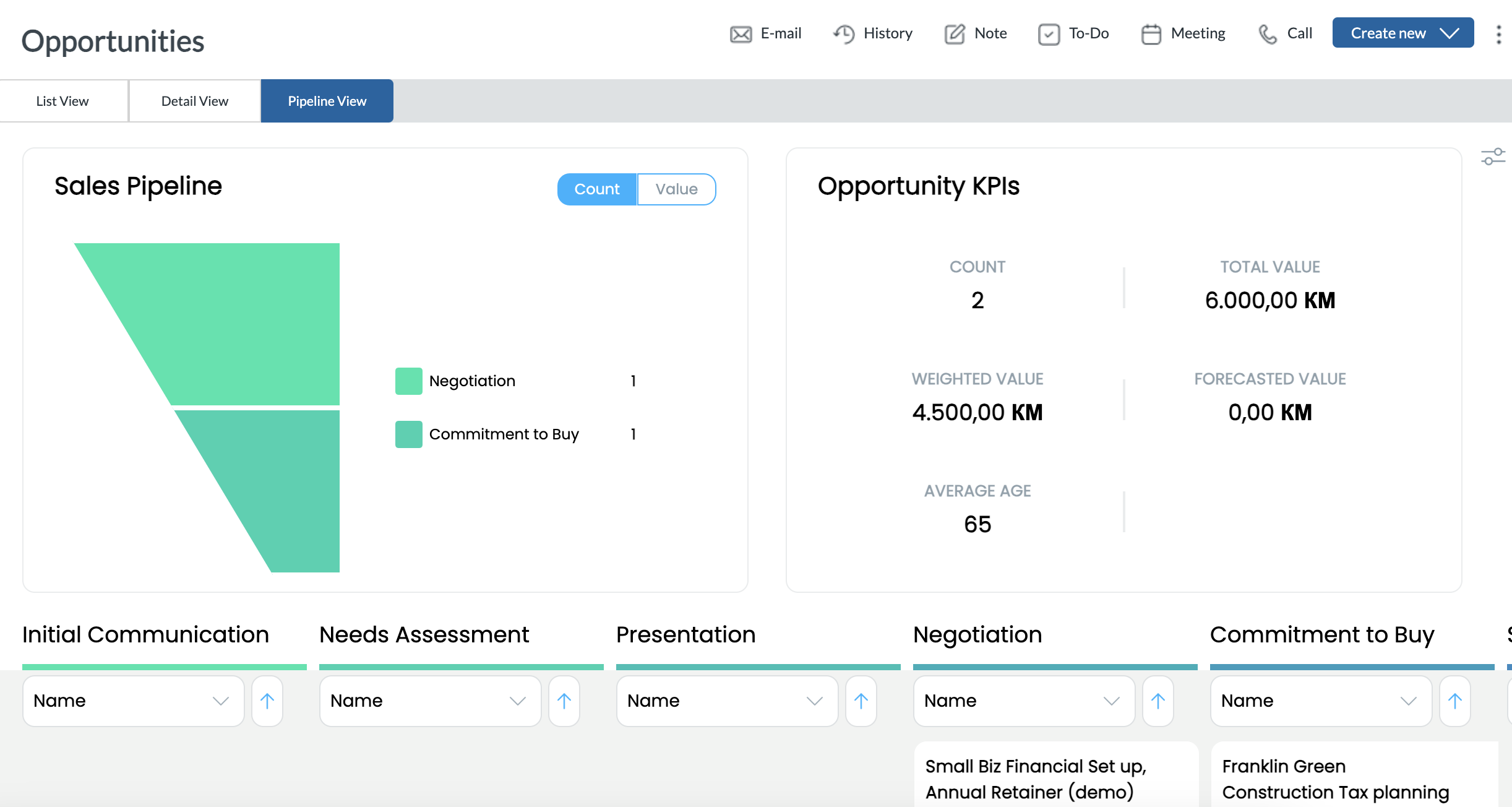
In addition to the “Pipeline” view, there are also two more views - the “Detail” and the “List” view - just like for contacts and companies.
The Detail view displays essential information like opportunity name, value, win probability, and dates (open, estimated, and actual close dates). This view also consolidates all related contacts, notes, and activities, offering a comprehensive snapshot of each opportunity. This level of detail is invaluable, especially when assessing the potential and progress of each deal.
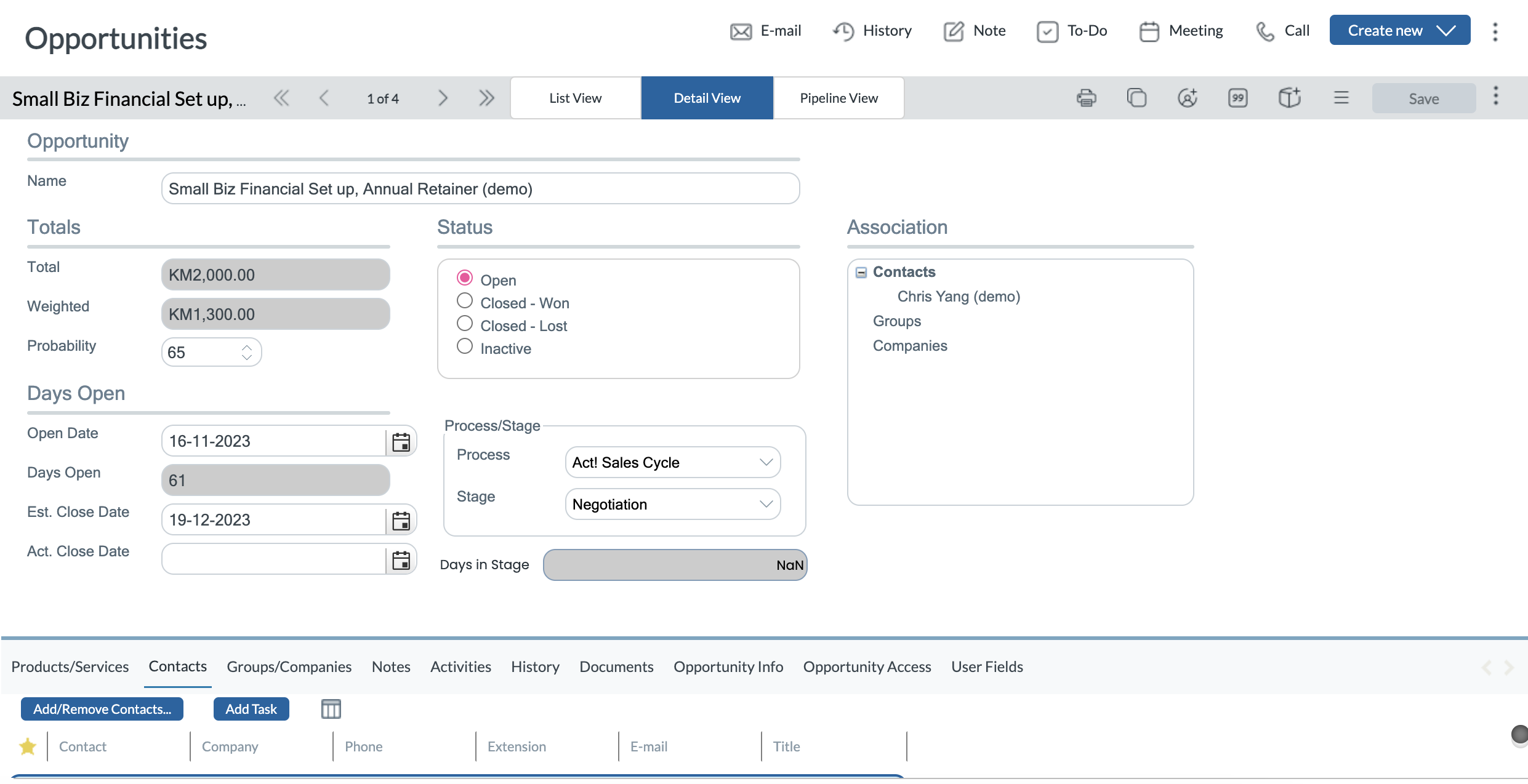
Calendar and Tasks
Act! CRM’s Calendar and Tasks features stand out for their simplicity and user-friendliness. Unlike some of the other more complex features of Act! CRM, the Calendar is refreshingly straightforward and uncluttered. It offers four viewing options – daily, weekly, monthly, and work week – which cater to different planning needs without overwhelming the user.
Adding new appointments is a breeze; right-clicking on a desired day and time brings up the “Schedule Activity” button in a drop-down menu that opens up. After that, a new window will open up, allowing you to add details such as notes, duration, type of activity, and association with contacts or companies.
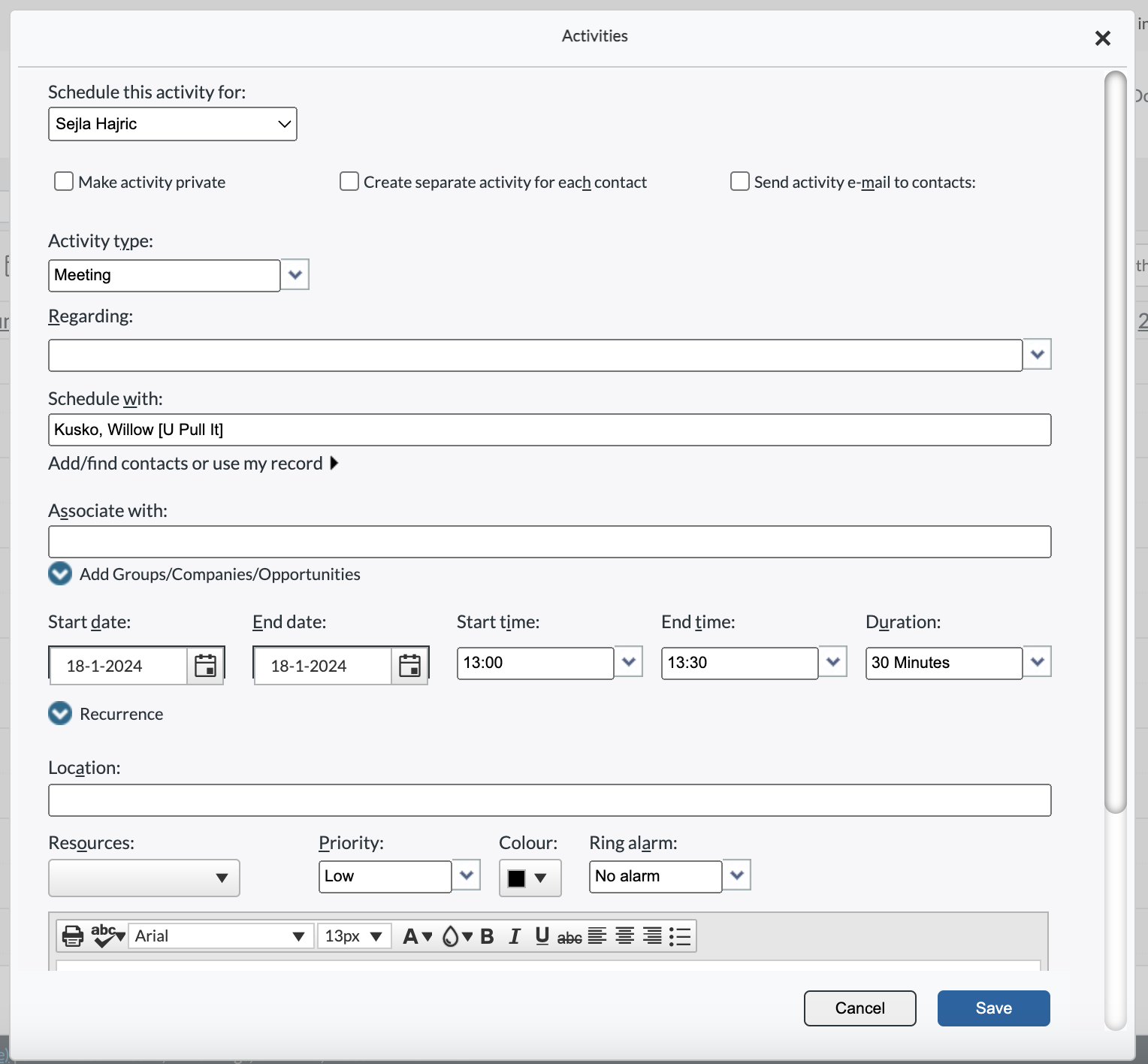 Although only available in a list view, the Tasks feature mirrors this simplicity. Creating a new task is just a matter of clicking the “Add Task” button in the top right corner, followed by similarly entering relevant details to the Calendar.
Although only available in a list view, the Tasks feature mirrors this simplicity. Creating a new task is just a matter of clicking the “Add Task” button in the top right corner, followed by similarly entering relevant details to the Calendar.
This consistency in design between Calendar and Tasks minimizes the learning curve and streamlines task management. The ability to filter tasks – for today, upcoming, or past dates, with the option for custom date ranges – provides an efficient way to prioritize and manage activities.
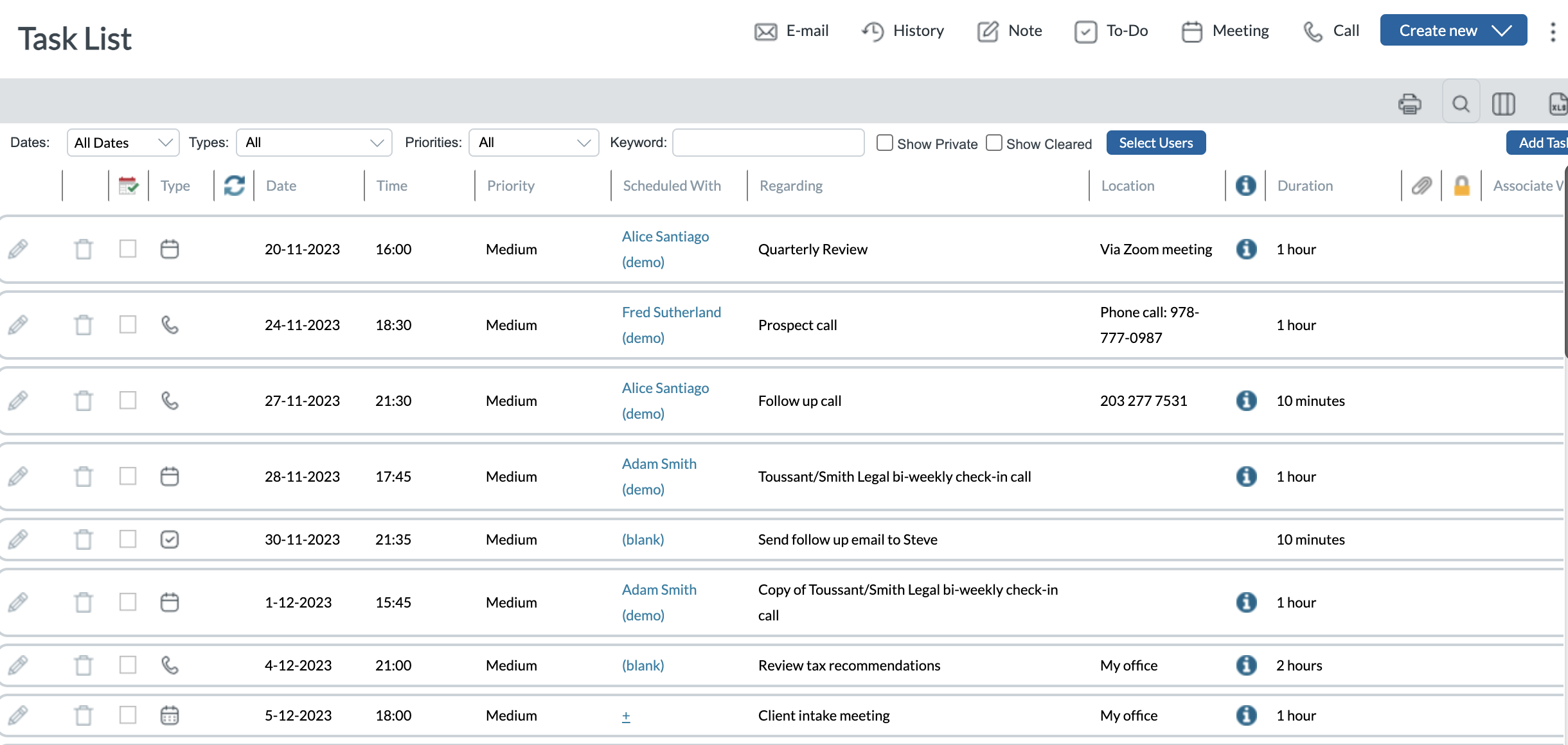
Marketing Automation
How good is Act!'s Marketing Automation feature? Well, it's good enough for it to land on our best marketing CRM software list! This CRM offers a comprehensive suite of email marketing tools. This marketing solution includes setting up campaigns featuring customizable email templates, automatic response systems, and the capacity for bulk sending emails.
Act! CRM offers a variety of campaign types, including drip marketing campaigns, nurture marketing, and general email campaigns. A visually intuitive workflow designer is also available, allowing users to automate each marketing campaign aspect easily, aligning perfectly with the Act! experience.
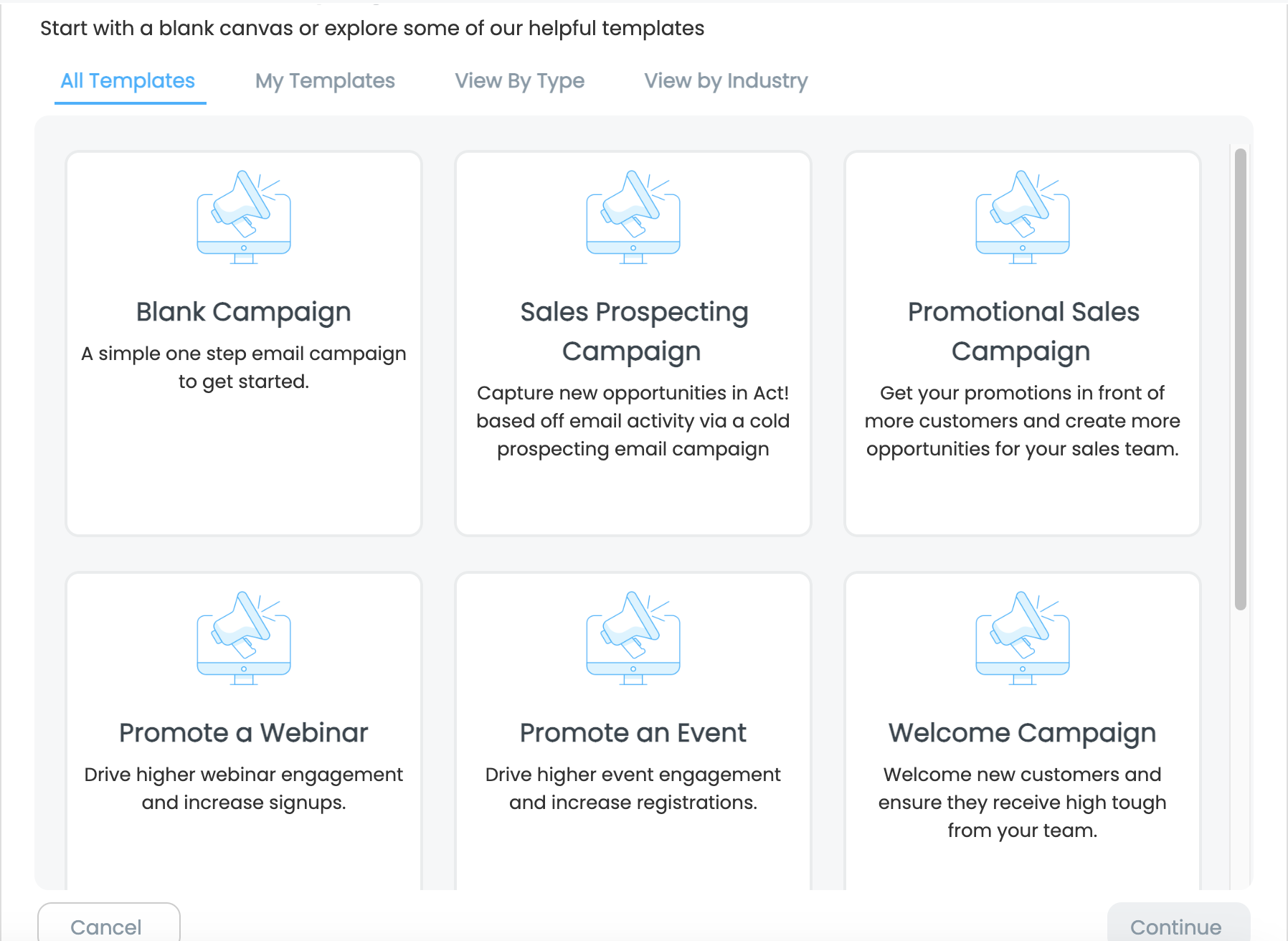
Also, you can create landing pages with Act CRM, which is essential for capturing leads via your website. Each landing page can be linked to a specific marketing campaign. Additionally, Act! CRM has lead scoring and web activity tracking features that help businesses prioritize leads based on their engagement and interactions.
Integration with Act! CRM’s database allows for seamless synchronization of marketing activities with customer relationship management.
Now, how intuitive is the marketing automation feature? To be fully transparent, it’s not that easy to use at first. But don’t let this scare you, as the learning curve is minimal, and you can master using this feature in less than an hour thanks to the video materials available.
 When trying to create a marketing campaign, we realized that our campaign had the wrong name. We wanted to edit the name by clicking the Edit button, but it only took us to the page where we could edit the campaign automation process.
When trying to create a marketing campaign, we realized that our campaign had the wrong name. We wanted to edit the name by clicking the Edit button, but it only took us to the page where we could edit the campaign automation process.
After playing around a bit, our CRM experts discovered that all changes to the campaign must be made by clicking the “Action” button in the top right corner. When you click on it, the “Campaign Properties” button takes you to a new window where you get to edit the essential info regarding the campaign.
Now, let’s get into setting up a marketing campaign automation. When creating a campaign, you can choose from existing templates or create your templates and choose from them.
Our first step was to create a campaign from one of the pre-made templates. Initially, the process seemed daunting; understanding the campaign's workflow was straightforward, but editing it could have been more intuitive. Fortunately, the Act! Marketing Automation Training Library provided a lifeline, with informative videos that demystified the editing process in under 30 minutes.

We thought the workflow designer would feature drag-and-drop functionality, which is even simpler. If you want to add a new step in your campaign or edit an existing one, you only have to click on the step, and voila - you can edit it or add a new step before/after it.
So, here’s an example. Let’s say you want to edit the first email that is supposed to be sent when you add a customer to your pipeline. Click on the step, and a new window will appear.
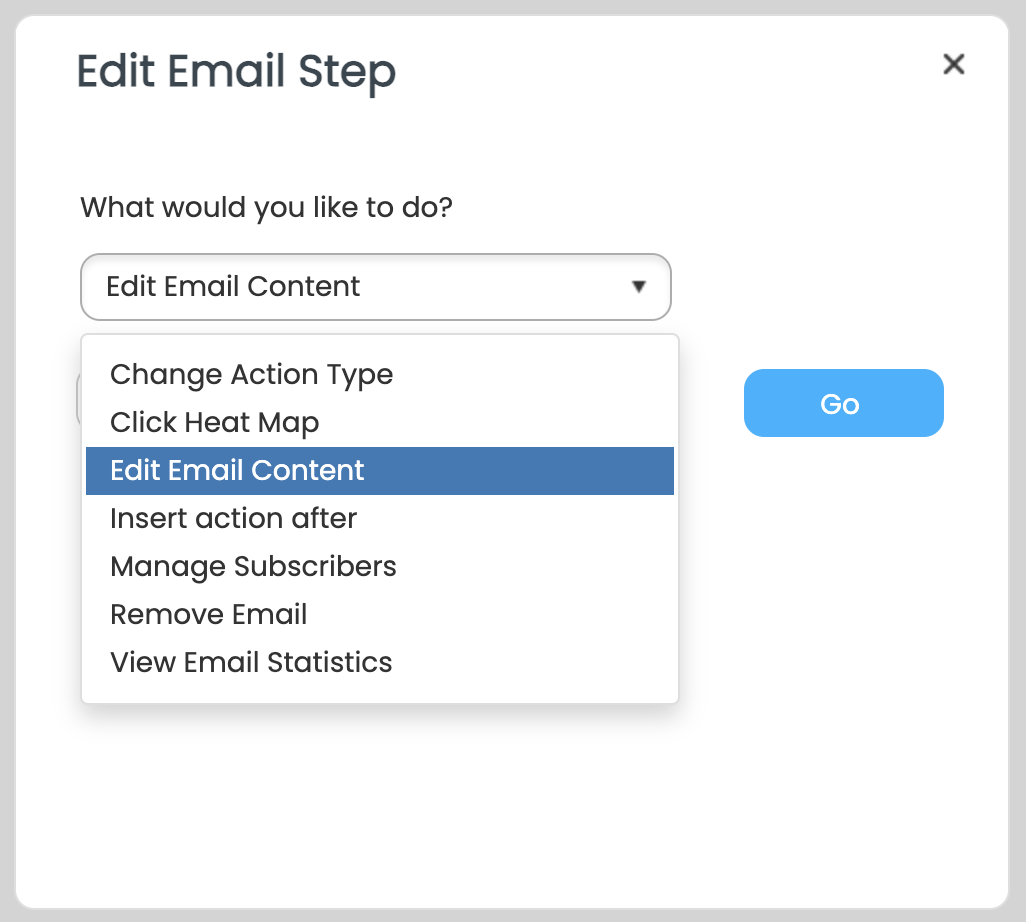
This window gives you multiple options – you can choose to edit the email content, insert a new action after that action was performed, remove the action, or change the action type (e.g., change from sending an email to scheduling an event).
Despite initial complexities, the system proved to be adaptable and efficient for campaign management. We sincerely recommend watching the training videos before creating your own campaign.
User Support & Training
From the very first log-in to Act! CRM, we noticed there are sufficient resources to learn how to use the tool. The dashboard’s welcome links provide easy access to How-To articles, a Knowledge Base, and a Getting Started Guide. The Getting Started page, though basic, efficiently introduces the CRM’s basics through tutorial videos, such as importing contacts.
The How-To page is packed with resources, including a Quick Start Guide and a Training Video Library, all systematically organized with FAQs on various topics linked to detailed articles for deeper understanding.
The Premium Knowledge Base in Act! CRM, categorized for easy navigation, helps find information on specific features like analytics. The Training Video Library also offers visual tutorials on each feature, accessible through the help button.
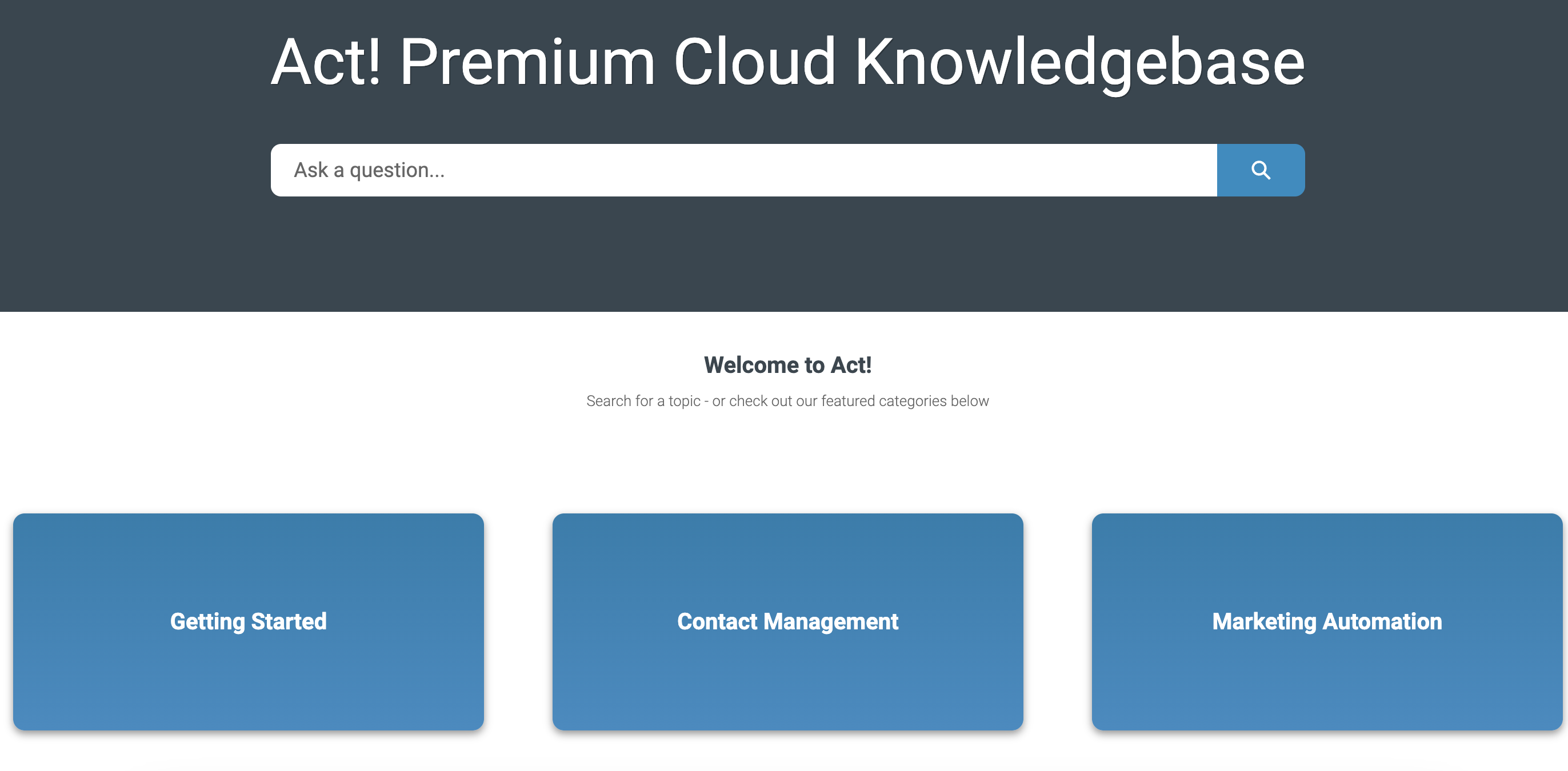
Customer support in Act! CRM is split into Standard and Enhanced tiers, with the former providing essential support and the latter offering additional services like priority support for an extra fee of $10/month.
Additionally, Act! CRM's network of verified Channel Partners offers customized solutions and professional training for sales teams, emphasizing their commitment to supporting business growth and CRM optimization.
Scalability
Act! is one of the best CRM systems for small businesses, focusing on client relationships and lead management. It offers strong foundations in contact and opportunity management, but its ability to scale may be limited for rapidly growing or larger businesses, mainly due to constraints in custom reports and dashboards.
The pricing structure of Act! CRM is budget-friendly for smaller businesses, with plans starting at $30 per user per month for the Premium Cloud and $37.50 for the Premium Desktop version. The availability of additional Marketing Automation plans and various add-ons provides flexibility for businesses to expand their CRM capabilities as they grow.
While Act! CRM can adjust to some degree for expanding businesses, but it may not be the best fit for large enterprises or those with more complex CRM needs. In such scenarios, considering more advanced CRM solutions could be beneficial. Overall, Act! CRM remains a solid option for small businesses needing essential CRM features with a potential for scaling.
Act! CRM Pricing Plans
Here’s a brief overview of Act CRM pricing:
Plan | Annual price | Website |
Act! Premium Cloud | $30/user/month | |
Act! Premium Desktop | $37.50/user/month | |
Act! Premium cloud w/ desktop sync | $40/user/month |
All Act! Premium plans include basic Marketing Automation features. There are three more plans you can subscribe to for additional marketing features:
AMA Select: $79/user/month, billed annually.
AMA Complete: $199/user/month, billed annually.
AMA Advanced: $399/user/month, billed annually.
Act! CRM also offers several add-ons for the following price:
Enhanced support - $10/user/month
Custom Tables – $10/user/month
Additional Cloud Storage – $5/month
SMS4Act! Text Messaging - $19/month
Hybrid with Desktop sync - $10/month
For more details on pricing and what each plan or add-on includes, please visit Act! CRM’s official website.
ACT complaints & praise (from real ACT software reviews)
Wondering what other people have to say about this software? We looked at a broad swathe of ACT CRM reviews from real users. Here’s what they had to say:
User reviews praise the app’s straightforward functionality and ability to handle a large volume of contacts. Sales teams enjoy its ease of use for lead management and follow-up, with automated emails and notifications via the alarm feature.
Others suggest it's an excellent investment for company growth, having an appreciable effect on the ability to scale.
While still skewing positive, some reviews pause to note the app’s reporting is not so intuitive. In general, the UX is mentioned as being difficult to navigate compared to newer design-focused CRM platforms.
Occasional glitches and buggy features were a frustration for some users.
Review of ACT CRM customer service support
If you ever encounter a problem when using this software, you will probably turn to customer service support first.
We scoured ACT customer support from real users and found a lot of praise for customer service support in explaining features and fixing problems. On the other hand, some wished their support staff would give more help with building reports.
The majority of users opt for standard customer support. However, those who choose enhanced technical customer support rarely have any complaints.
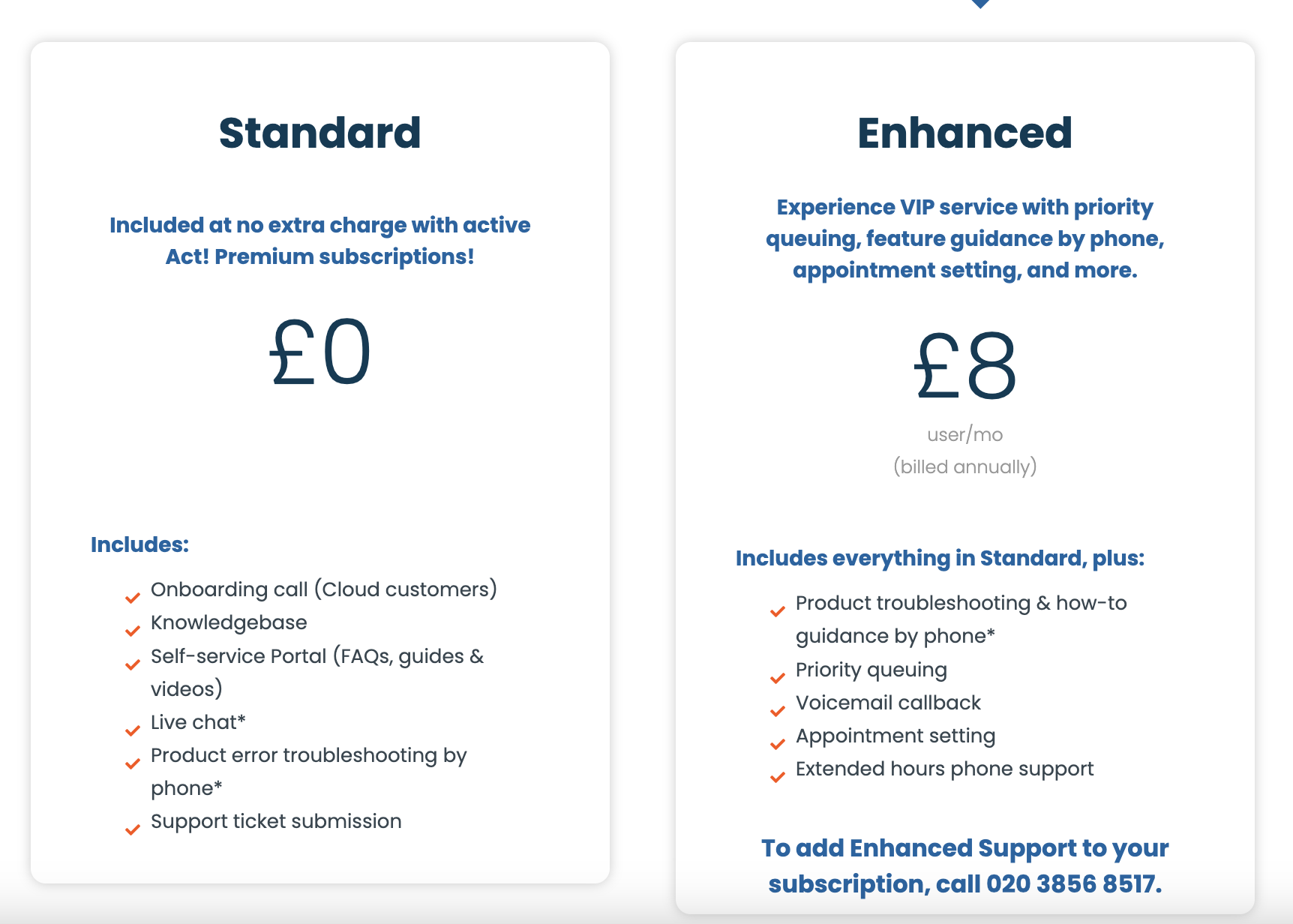
Is ACT contact management software worth it? Key takeaways
Is ACT worth it? The answer is a "yes, if..." It's's a great choice for small businesses and mid-size outfits looking for an affordable contact management software solution with features that are more than the standard. You might be tempted to look elsewhere if your company size is enterprise-level.
This software is great for beefing up marketing processes, lead management, and keeping track of customer contacts and sales opportunities. It's straightforward and performs excellently as a CRM.
However, as noted, the software has some drawbacks. The platform's reporting features and overall navigation could be more intuitive, presenting a slight learning curve. For larger enterprises, the software might fall short of complex CRM needs. While ACT CRM holds its own as a competent CRM solution, those at the enterprise level or requiring advanced reporting might consider exploring other options.
Overall, for its targeted user base, ACT CRM offers a commendable balance of functionality, ease of use, and affordability.
Act CRM FAQs
What is ACT CRM used for?
ACT CRM is a versatile customer relationship management tool primarily used for centralizing customer information, managing sales opportunities, and enhancing marketing efforts. The platform streamlines the process of tracking customer interactions and leads, enabling businesses to manage client relationships efficiently and tailor their marketing strategies to meet customer needs.
What is the Act database?
The Act database is the core component of ACT CRM where all customer data is stored and managed. It's a comprehensive repository that houses contact details, interaction histories, sales records, and other critical client information. This database serves as the backbone of the CRM, providing users with easy access to customer insights and facilitating effective sales and marketing activities.
Who owns the Act CRM?
ACT CRM is owned by Swiftpage, a company renowned for its commitment to providing powerful yet user-friendly software solutions for small and medium-sized businesses. Swiftpage's acquisition of ACT CRM has led to significant enhancements in the software's capabilities, focusing on improving user experience and expanding CRM functionalities to meet the evolving needs of modern businesses.
Does ACT CRM have an app?
Yes, ACT CRM offers a mobile app available for both iOS and Android devices. This app extends the functionality of the CRM platform to mobile devices, allowing users to access and manage customer data, track sales opportunities, and perform various CRM tasks on the go. The app ensures that users can stay connected with their customer base and business operations, regardless of their location.




